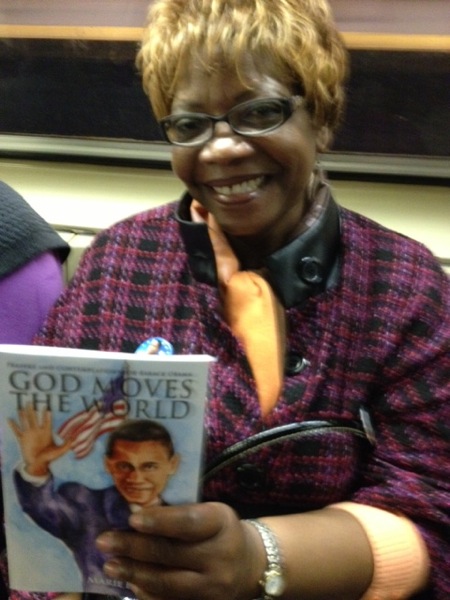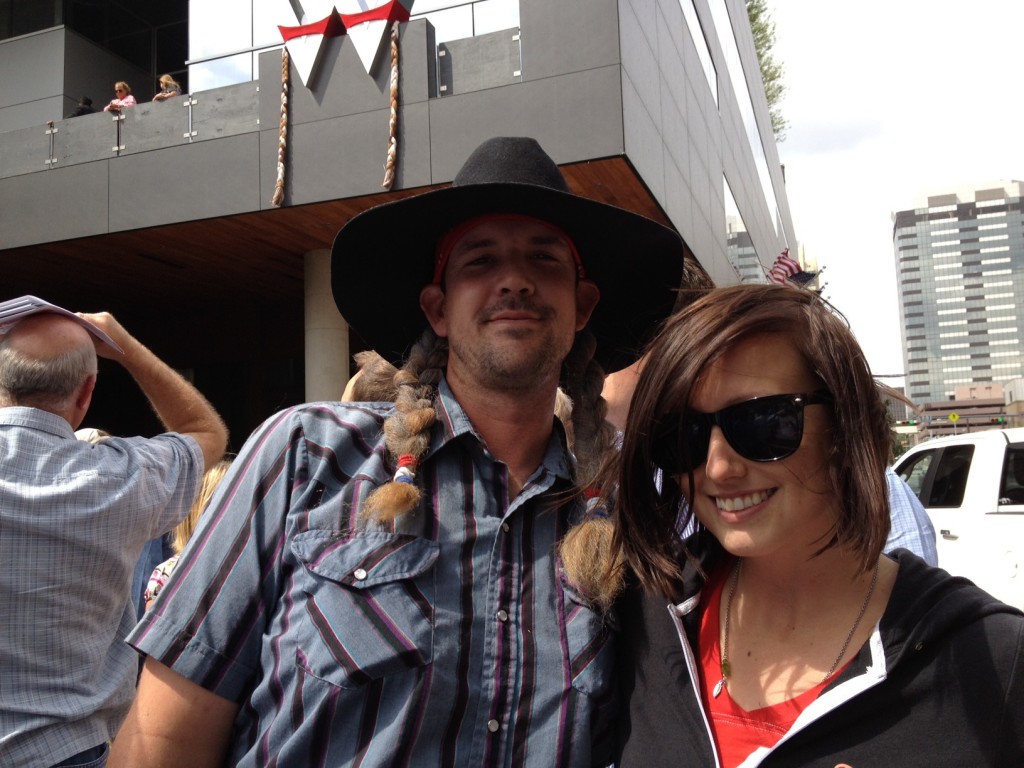Uncategorized
TEDx Talk: Subway Photography
UncategorizedLast month, I gave a talk about subway photography at TEDxHCCS — an event at Hunter, where I went to school.
Dreams From Her Father
UncategorizedOn the way to 29th Street Wednesday morning, I saw a woman looking through a book titled God Moves the World with a drawing of President Obama on the cover. As part of my subway photography project, I pay attention to the reading habits of religious commuters. Their texts rarely descend to worldly matters such as Presidential politics, so I asked about this one.
The reader pointed to the woman sitting next to her: Marie E. Pierre, the author of God Moves the World: Prayers and Contemplations for Barack Obama:
All her life, Marie has had periods of dreams centered on a common theme. During the [2008] election and in the early days of the Obama presidency, Marie experienced a series of recurring dreams seeking expression. With a pen and notepad next to her bed, Marie would awaken and remain as suspended in her dream-state as possible while she wrote down the thoughts and images streaming into her consciousness.
Available as an e-book and in paperback, God Moves the World sounds like a manifestation of my colleague David Jacobs (and Shaquille O’Neal before him) call dreamful attraction.
Marie published God Moves the World in August, so I’m guessing she still sees in the President, as she put it, “a potential similar to that of Moses – the ability to lead the people of America out of darkness.”
Sweet dreams, Marie!

Stanley Kubrick Rides the Subway
UncategorizedNineteen-year-old Stanley Kubrick explains how he took these photographs:
“I wanted to retain the mood of the subway, so I used natural light,†he said. People who ride the subway late at night are less inhibited than those who ride by day. Couples make love openly, drunks sleep on the floor and other unusual activities take place late at night. To make pictures in the off-guard manner he wanted to, Kubrick rode the subway for two weeks. Half of his riding was done between midnight and six a.m. Regardless of what he saw he couldn’t shoot until the car stopped in a station because of the motion and vibration of the moving train. Often, just as he was ready to shoot, someone walked in front of the camera, or his subject left the train.
Kubrick finally did get his pictures, and no one but a subway guard seemed to mind. The guard demanded to know what was going on. Kubrick told him.
“Have you got permission?†the guard asked.
“I’m from LOOK,†Kubrick answered.
“Yeah, sonny,†was the guard’s reply, “and I’m the society editor of the Daily Worker.â€
For this series Kubrick used a Contax and took the pictures at 1/8 second. The lack of light tripled the time necessary for development.
— “Camera Quiz Kid: Stan Kubrick,” The Camera, October 1948
Willie Nelson Gets a Statue in Austin
UncategorizedOn Thursday night, I arrived in Austin to attend the 13th annual International Symposium on Journalism, at the University of Texas. A couple of hours earlier, the college of communication named a cactus-and-concrete plaza after Walter Cronkite, who spent a couple of years there on his way to becoming the most trusted man in America, and premiered “All the News That’s Fit to Print,” a projection by my neighbor Ben Rubin. At the four corners of the plaza, plaques extol four virtues he embodied: Accuracy, Courage, Independence, and Integrity. Each plaque has a bas-relief of Cronkite and a paragraph of commentary. On the Integrity plaque, for example, it says. “Walter Cronkite held firm to a strict code of moral values.”
On Friday afternoon, after my panel on the mobile revolution, I headed down to the corner of Second and Lavaca for the unveiling of a statue of Willie Nelson, who came to Austin forty years ago. Through a diaphanous khaki tarp, all you make out was the neck of the guitar.
Both Second (now known as Willie Nelson Boulevard) and Lavaca were closed to traffic, and two vehicles parked in the middle of Lavaca: a flatbed truck to give camera crews a better view, and an blue-and-red Airstream with Shiner Bock, Tito’s Handmade Vodka, and other refreshments for working press.
Katherine Stolp, the weekend anchor for Austin’s CBS affiliate, was on hand to cover the ceremony, which was streamed live on the KEYE Web site and would lead the 6 p.m. news. She hadn’t covered the Cronkite event, but KEYE had. When asked who she admired more, the anchorman or the outlaw country-music pioneer, Stolp at first said Cronkite, but then said, “It’s really a toss-up.” Cronkite, she said, “was always genuine. You felt like could believe him. Kind of like I feel about Willie Nelson when I watch him.”
Josh McHenry and Allyson Stephens took the day off—she’s the assistant manager at an apartment complex, he does maintenance—to attend the unveiling. “I was supposed to be in California today, but this took precedence,” added McHenry, who wore a red bandana and a pair of yarn braids, in tribute to his musical idol.
So did Eddy Wilson, who is almost four months old, according to Kacie Case, who was wearing Eddy, facing inward, in a sling.
Even the sans-serif W of Austin’s new W hotel, which is right next to the statue, dressed for the occasion.
The ceremony was scheduled for 4:20 pm on April 20th—a numerologically significant moment for Nelson and other supporters of legalizing marijuana. It began a few minutes after four, and the emcee introduced Lawrence Wright, the president of Capital Area Statues, Inc., the nonprofit organization which raised the money for the statue, its third. (Read about the first and second.)
Then Mayor Lee Leffingwell took the podium. As he thanked various municipal officials, three guys upwind of me started passing around joints. (Can you imagine Mayor Bloomberg helping a weed-friendly crowd to canonize one of their idols on their high holiday?) To the right, someone looked at his phone and noticed that it was already 4:22. “They blew it on the timing,” he grumbled. “Maybe they got stoned earlier.”
At 4:27, the khaki tarp was removed, and the crowd cheered. Willie Nelson looked at the larger than life bronze of himself. He felt the smiling statue’s arm, then the guitar neck. He posed for a photograph with the sculptor, Clete Shields. Nelson thanked the Austin, then said, “While I’ve got this guitar…” and the whooping crowd drowned out the rest of his sentence. He sang “On the Road Again,” with help from the audience, then “Roll Me Up and Smoke Me When I Die” before slowly making his way to the pastel-painted tour bus with indian chief on the side.
He sang both songs again on Saturday night at the Backyard, out in Bee Cave, plus a whole lot more—but not my favorite, “Sad Songs and Waltzes.”
Living Without a Laptop
UncategorizedWith a desktop at home, I’m trying to see whether I can make do with the iPad (first version) plus a $60 wireless keyboard instead investing in a new laptop. Even with the on-screen virtual keyboard, writing on the iPad was as easy, if not easier, than on a full-featured computer. The iPad is getting better at multitasking, but it’s still easier to focus on doing one thing at a time, and distractions such as Growl or Twitter aren’t in the picture plane. Plus I’m working in the cloud, using PlainText, which lets me use my Textexpander shortcuts, so I can resume anywhere.
Mail recognizes keyboard shortcuts for cut, paste, and undo, but it could easily use basic keyboard commands for replying to messages. And Safari could also support keyboard commands that send me to the status bar or search box. And neither application supports Textexpander, unfortunately. (MarkdownMail lets you write e-mail using Textexpander, but it’s not a mail client.) Although they probably could; the Settings have an option for shortcuts. So I’m writing this post in the Web browser without the benefit of my own personal shorthand.
Also, power is a problem. With Bluetooth enabled, the iPad battery drains much more quickly, even when you’re not using the keyboard. So you have to remember to disable Bluetooth before you put the machine back in your bag.
It wouldn’t take much for Apple to make the iPad plus keyboard a better laptop replacement. But then fewer people would need to buy laptops?
What Killed Andrew Breitbart?
UncategorizedMany of his familiars called him a “happy warrior,†but worried about his health because he never seemed to unplug.
This short paragraph, from David Carr’s Sunday Style piece gets closest to what I’ve been wanting to read about Andrew Breitbart, who died at 43. But then the story returns to the prevailing narrative: that bile, especially right-wing bile, is poisonous, and for Breitbart the toxicity finally reached fatal levels.
“If Twitter ever killed anyone, it was Andrew,†said Mr. Labash of The Weekly Standard. “Andrew was a magnet for hatred, and he used Twitter for a full frontal assault, a tool of combat,â€
I’m surprised that opponents of Breitbart believe in divine justice. Maybe the man—who had a history of heart ailments, his father-in-law says—just worked himself to death on the hamster wheel of online news?
But that’s speculation, too:
(A final coroner’s report, with the official cause of death, is expected this month.)
Audio and the Imagination
UncategorizedWhen I started working in radio twenty years ago, I just instantly loved it. And it gives you so much creative freedom, because you can pretend so much on the radio. You can pretend like a lot is going on, even if it’s not, you know? Which you cannot do if you have a camera.
Reykjavik mayor Jón Gnarr to Benjamen Walker on Too Much Information, 42:34.
Grandfather Needs Money for a Funeral
Uncategorized Perhaps you’ve seen this guy on the train. He carries a folded newspaper and tells a story about his 4-year-old granddaughter, who was accidentally shot and killed in the Bronx. He needs to raise nineteen dollars for the funeral, at “St. Mary’s on Gun Hill Road.”
Perhaps you’ve seen this guy on the train. He carries a folded newspaper and tells a story about his 4-year-old granddaughter, who was accidentally shot and killed in the Bronx. He needs to raise nineteen dollars for the funeral, at “St. Mary’s on Gun Hill Road.”
I saw him twice in the past two weeks. My suspicions that this was a scam were raised the first time—I’ve heard my share of false testimony—but my 7-year-old son couldn’t stop watching him; he thinks people die when they are old, and was shaken by the story of this 4-year-old girl. Which was why I was so bothered the second time, a day after he said the funeral was supposed to happen. Now it was supposed to happen “tomorrow.” I held up my camera to take this picture, so he could see me doing so, then said in front of the rest of the car that I’d heard him tell this story before. “That’s what I said last week,” he said, and started at me. I stared back. A man gave him a dollar.
I can’t prove anything, but I called the Archdiocese of New York. There are two St. Mary’s in the Bronx; neither is on Gun Hill Road. There’s an Episcopal one too, not on Gun Hill Road.






